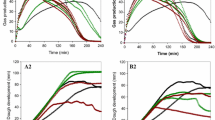Abstract
Effects of transglutaminase (TGase) and proteins such as whey protein, caseinate, and soy protein on the preparation of gluten-free rice breads using non-waxy rice flour were investigated. Rice flour (about 12% moisture content) was prepared from dry milling of dried grain after rice got soaked. Unlike general dry milled flour, newly developed rice flour increased water binding capacity (WBC), swelling power, and peak viscosity. Soy protein increased WBC but other proteins slightly decreased with the increase of levels. Lightness decreased and yellowness increased with the addition of whey and soy protein. All pasting viscosities decreased with the addition of protein. The TGase improved the network structure of rice batter. The 2nd proof time of rice batter with protein was shortened by 4–9 min with the addition of TGase. The specific volumes of rice breads with whey and soy protein also increased. TGase and protein additions decreased the hardness of rice bread. Sensory test showed that roasted flavor, volume, air cell homogeneity, and overall quality were significantly different (p<0.05) with protein and TGase additions.
Similar content being viewed by others
References
Shan L, Molberg O, Parrot I, Hausch F, Filiz F, Gray GM, Solid LM, Khosla C. Structural basis for gluten intolerance in celiac sprue. Science 297: 2275–2279 (2002)
Gallagher E, Gormley TR, Arendt EK. Crust and crumb characteristics of gluten-free breads. J. Food Eng. 56: 153–161 (2003)
Schober TJ, Messerschmidt MM, Bean SR, Park S-H, Arendt EK. Gluten-free bread from sorghum: Quality differences among hybrids. Cereal Chem. 82: 394–404 (2005)
Shin M, Gang DO, An YH. The preparation methods of rice flour mix and rice bread. Korean Patent 10-0742572 (2007)
Gujral HS, Guardiloa I, Carbonell JV, Rosell CM. Effect of cyclodextrinase on dough rheology and bread quality from rice flour. J. Agr. Food Chem. 51: 3814–3818 (2003)
Gujral HS, Rosell CM. Functionality of rice flour modified with a microbial transglutaminase. J. Cereal Sci. 39: 225–230 (2004)
Moore MM, Schober TJ, Dockery P, Arendt EK. Textural comparison of gluten-free and wheat-based doughs, batters, and breads. Cereal Chem. 81: 567–575 (2004)
Sivaramakrishnan HP, Senge B, Chattopadhyay PK. Rheological properties of rice dough for making rice bread. J. Food Eng. 62: 37–45 (2004)
Ahlborn GJ, Pike OA, Hendrix SB, Hess WM, Clayton SH. Sensory, mechanical, and microscopic evaluation of staling in low-protein and gluten-free breads. Cereal Chem. 82: 328–335 (2005)
Song JY, Shin M. Effects of soaking and particle sizes on the properties of rice flour and gluten-free rice bread. Food Sci. Biotechnol. 16: 759–764 (2007)
An YH, Gang DO, Shin M. Effects of transglutaminase on the physical properties of resistant starch-added wheat flour doughs and baguettes. Food Sci. Biotechnol. 14: 608–613 (2005)
Basman A, Koksel H, Ng PKW. Effects of transglutaminase on SDS-PAGE patterns of wheat, soy, and barley proteins and their blends. J. Food Sci. 67: 2654–2658 (2002)
Nonaka M, Tanaka H, Okiyama A, Motoki M, Ando H, Unda K, Matsura A. Polymerisation of several proteins by Ca2+ independent transglutaminase derived from micro-organisms. Agr. Biol. Chem. Tokyo 53: 2619–2623 (1989)
Marco C, Rosell CM. Effects of different protein isolates and transglutaminase on the rice flour properties. J. Food Eng. 84: 132–139 (2008)
Kang IJ, Matsumura Y, Ikura K, Motoki M, Sakamoto H, Mori T. Gelation and gel properties of soybean glycinin in a transglutaminase-catalyzed system. J. Agr. Food Chem. 42: 159–165 (1994)
Babiker EE. Effect of transglutaminase treatment on the functional properties of native and chymotrypsin-digested soy protein. Food Chem. 70: 139–145 (2000)
Ahn HJ, Kim JH, Chang YH, Steffe JF, Ng PKW, Park HR. Effects of transglutaminase on pasting and rheological properties of different wheat cultivars blended with barley or soy flour. Food Sci. Biotechnol. 17: 52–57 (2008)
Renzetti S, Arendt EK. Effect of protease treatment on the baking of brown rice bread: From textural and rheological properties to biochemistry and microstructure. J. Cereal Sci. 50: 22–28 (2009)
Moore MM, Heinbockel M, Dockery P, Ulmer HM, Arendt EK. Network formation in gluten-free bread with application of transglutaminase. Cereal Chem. 83: 28–36 (2006)
Ronda F, Gomez M, Caballero PA, Oliete B, Blanco CA. Improvement of quality of gluten-free layer cakes. Food Sci. Technol. Int. 15: 193–202 (2009)
Marco C, Rosell CM. Breadmaking performance of protein enriched, gluten-free breads. Eur. Food Res. Technol. 227: 1205–1213 (2008)
AACC. Approved Methods of the AACC, 10th ed. The American Association of Cereal Chemists’, St Paul, MN, USA (2000)
Williams PC, Kuzina FD, Hlynka IA. A rapid colorimetric procedure for estimating the amylose content of starches and flours. Cereal Chem. 47: 411–420 (1970)
Medcalf DF, Gilles KA. Wheat starches. I. Comparison of physicochemical properties. Cereal Chem. 42: 558–568 (1965)
Schoch TJ. Swelling power and solubility of granular starches. Vol. IV, pp. 106–108. In: Methods in Carbohydrate Chemistry. Whistler RL, Smith RJ, BeMiller JN, Wolfrom ML (eds). Academic Press Inc., New York, NY, USA (1964)
Kim WS, Shin M. The properties of rice flours prepared by dry- and wet-milling of soaked glutinous and normal grains. Korean J. Food Cookery Sci. 23: 908–918 (2007)
Renzetti S, Bello FD, Arendt EK. Microstructure, fundamental rheology, and baking characteristics of batters and breads from different gluten-free flours treated with a microbial transglutaminase. J. Cereal Sci. 48: 33–45 (2008)
Truong VD, Clare DA, Catignani GL, Swaisgood HE. Cross-linking and rheological changes of whey proteins treated with microbial transglutaminase. J. Agr. Food Chem. 52: 1170–1176 (2004)
Author information
Authors and Affiliations
Corresponding author
Rights and permissions
About this article
Cite this article
Shin, M., Gang, DO. & Song, JY. Effects of protein and transglutaminase on the preparation of gluten-free rice bread. Food Sci Biotechnol 19, 951–956 (2010). https://doi.org/10.1007/s10068-010-0133-8
Received:
Revised:
Accepted:
Published:
Issue Date:
DOI: https://doi.org/10.1007/s10068-010-0133-8




